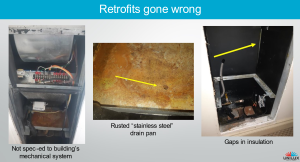How would your owners feel to pay a million dollars twice for the same capital project within three years?
Whether the fan coil units are owned by the corporation or the unit owners, the condo board of directors has a duty of care and a financial interest in doing it right the first time.
A fan coil unit (FCU) is the heating and cooling equipment commonly found in condominium and apartment dwelling units. When designing a building, an engineer uses a heat loss calculation, which is a function of the suite’s square footage and exterior insulation, to size each fan coil. The size, measured in CFM (cubic feet per minute of air) or in MBH (thousand BTUs per hour) of every fan coil in the building, usually in the hundreds, are summed and used to determine the size of the chiller, boiler, risers, and pumps. The fan coil units connect to a larger, corporation owned, holistic system.

The useful lifespan of a fan coil is 20 to 25 years, after which there is an increased risk of floods, mold, and compromised indoor air quality. To properly replace a fan coil, regardless of whether it is owner owned or corporation owned, the board should follow these steps to ensure duty diligence:
- Review the original specifications found in the mechanical drawings. Many performance specifications were calculated by hand and are not accurate to today’s performance standards. As a secondary assurance, physical coil sizes should be measured and inputted into AHRI 410 standard software to calculate the performance specifications.
- Check with the original equipment manufacturer for the shop drawings or request them recalculate the specifications to standard AHRI 410.
- Ensure the performance specifications of the new equipment align with the existing corporation owned mechanical infrastructure.
- Ensure the replacement process follows today’s building codes and EACO Level 2 protocol to ensure resident and staff safety.
Here we look at two projects that went wrong:
Example 1: A 30-year-old condominium in Burlington with over 200 units paid $1 million in 2018 to replace their fan coils, and then paid $1.3 million in 2021 to replace them again.
Given the fan coil age and sufficient funds in the reserve, the board hired an engineering firm to manage replacement. The fan coil manufacturer chosen to build the replacement had inadequate experience. They attempted to copy the original design, without understanding the nuances of airflow and the need for a third-party performance certification. Consequently, this knock-off unit caused several expensive problems.
The retrofit issues came to light within a year after the project. A resident called Unilux because their original name plate was still on the access door, to complain about a lack of heating. Upon inspection, Unilux found the knock-off replacement fan coil unit to be under sized. Secondly, they lacked a name plate and a registered third-party inspection mark, such as ESA, ETL, UL, or CSA. These certifications are important to ensure that the mechanical equipment 1) performs as it should, and 2) will not cause an electrical fire. Thirdly, the drain pans had already rusted as the incorrect variant of stainless steel was used. Lastly, there were breaks in the thermal barrier within the cabinet, leading to condensation and drywall damage.
Upon further inspection, these problems were found to be consistent throughout the building. After a two-year legal pursuit for compensation, the board chose to have all 200 fan coils re-replaced.
Example 2: A 43-year-old building in downtown Toronto had maintained a “hands off” approach to fan coil units, leaving the repair and replacement at the sole discretion of the individual owners. Without having a clear understanding of the communal effects their fan coil has on the rest of the building, owners looked online for the cheapest knock-off units available.
This continued for many years until the multiple leaks and heating complaints reached a tipping point. In 2023 the board hired an engineering firm to perform an audit which uncovered under and oversized fan coil units and, once again, a lack of third-party certification. The replacement manufacturers were contacted to provide evidence of a third-party mark but were unable to do so. Due to this, the building has been flagged as a fire risk because the integrity of the electrical components could not be verified.

The board is now debating whether to force all owners to re-replace their fan coil(s) or to hire a third party to certify the electrical components. Either option is costly. Owners are furious because the previous board neglected to vet manufacturers and installers on their behalf.
To learn more, visit www.uniluxcrfc.com




